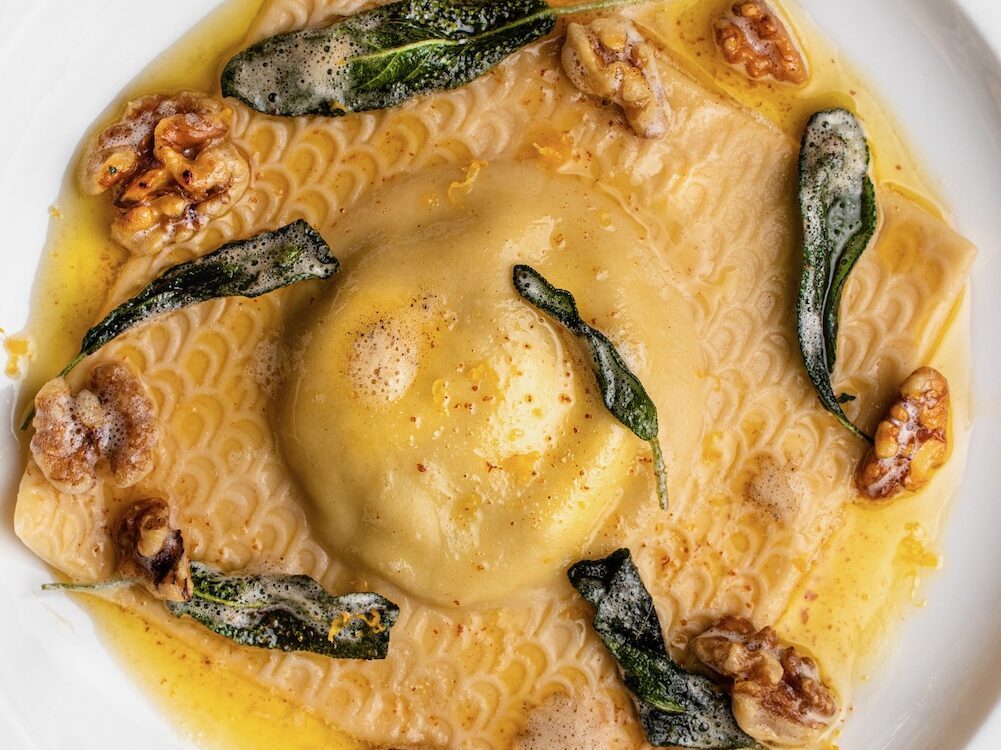
Pesto-Ricotta Filled Raviolo with Brown Butter, Crispy Sage & Walnuts
|
|
Time to read 3 min
|
|
Time to read 3 min
Introduction by Sarah Ubertaccio. Recipe and photos by Emilie Pullar.
Using a ravioli mold may seem daunting at first, but it’s actually rather simple and results in an impressive-looking pasta. Plus, compared to other hand-folded filled pasta, which can take hours to prepare (think: folding all those little tortellini and cappelletti by hand), making giant ravioli creates a higher yield in far less time.
One of the ways to speed up the process further is to use a simple filling. Emilie’s hack? Combine ricotta with pesto and voila! You’ve got yourself a flavor-packed ravioli filling that comes together in seconds.
Since you’re only using two ingredients in the filling, it’s important to use the best quality that you can find of each. For the ricotta, choose one that’s whole milk and firm. If it seems watery, strain it over a tea towel or a cheesecloth to remove some of the excess moisture. As for the pesto, make your own or buy it fresh from the refrigerated section of your market. Look for a vibrant green color, a sign that the basil hasn’t oxidized. If basil pesto isn’t in season, try your hand at making a sage pesto, which would complement the brown butter sauce well.
You can make the ravioli in advance and store them in the fridge for up to 24 hours.

90 minutes
10 minutes
4
1 batch of fresh egg pasta dough
250 grams whole milk ricotta
2-3 tablespoons basil pesto (or any pesto you like!)
200 grams butter
20 sage leaves
¾ cup walnut pieces
Zest of 1 lemon
1. Make your pasta dough and rest for at least 30 minutes but preferably an hour or up to three.
2. Mix the ricotta and pesto together. Add the pesto to taste, you might want more or less. Put into a piping bag and chill in the refrigerator for at least 30 minutes (it’s easier to pipe when firm).
3. Roll out sheets of pasta to your desired thickness. I tend to do the second to thinnest which is setting 7 on my kitchen aid roller (the equivalent of setting 7 on a Marcato Atlas 150 pasta machine ).
4. Cut into squares just bigger than the size of the mold. Having some overhang is ideal. Brush one of the squares with 00 flour and then place the flour side down into the mold. There’s a fine line where the dough needs to be floured enough to not stick, but not so floured that it fills in the grooves in the mold and you lose detail. If the pasta sticks in the mold, I flip it upside down and give the bottom of the mold a few taps with a rolling pin until the pasta falls out.
5. Use a dry pastry brush to lightly press into the space the filling will go into. Pipe your filling into the middle, then press down and smooth with a teaspoon so that it’s level with the top of the mold. Place the second square on top and press lightly with your hands. Roll with a rolling pin then flip over and press down really firmly with your hands. Peel the raviolo off the mold, don’t panic if it sticks, you might just need to dust the first sheet with more flour next time. Cut off the edges with a knife or pizza cutter. You can also use a fluted wheel on the edges if you wish.
6. Cook the ravioli in well-salted boiling water for 4 minutes or until cooked to your liking.
7. While the pasta is cooking, melt the butter over medium-high heat. When it is just sizzling add the sage leaves and walnuts and cook, swirling the pan for 3 – 4 minutes until the sage leaves are crisp and the butter is just browned. Turn down the heat if your butter is browning too quickly.
8. Serve the ravioli on plates and top with the sage butter and walnuts. Grate some lemon zest and parmesan over each plate.